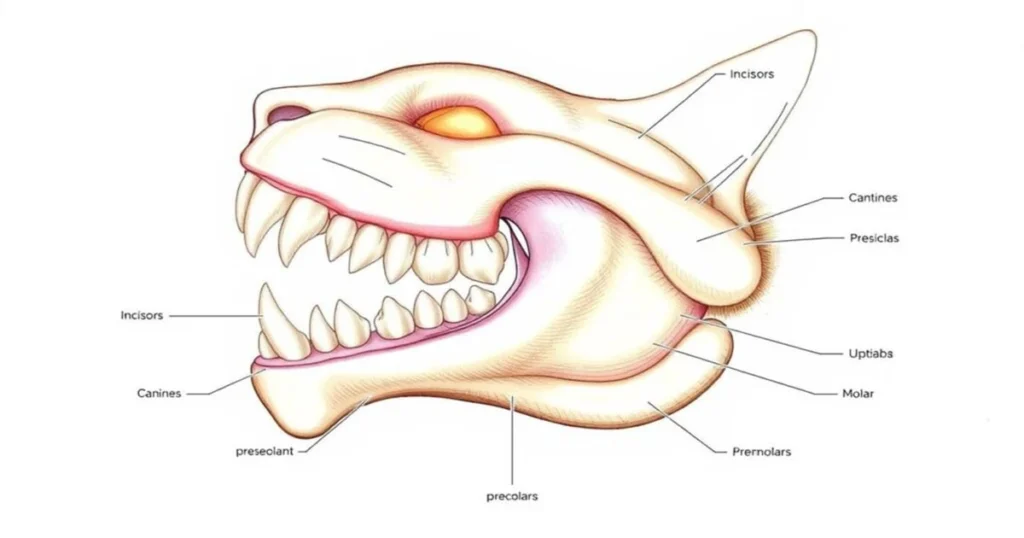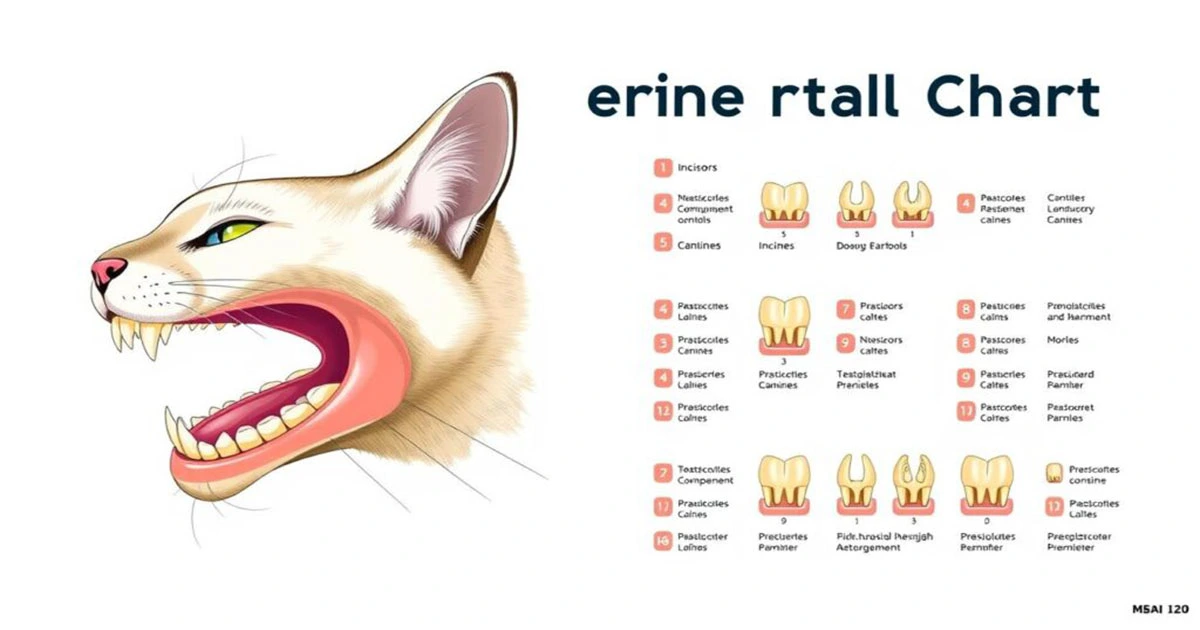As a devoted cat owner, knowing your cat’s dental anatomy is key for their health. A feline dental chart helps track your cat’s dental growth and spot problems early. Learning about typical tooth numbers and structures helps you manage your cat’s dental care better.
This guide will explore your cat’s dental anatomy in detail. We’ll look at the different types of teeth, their roles, and how they develop. With this info, you can spot dental issues early and keep your cat’s mouth healthy.
Table of Contents
Understanding Your Cat’s Dental Anatomy
Knowing about your cat’s dental anatomy is key to keeping their mouth healthy. It’s important to understand the types of teeth they have and how they develop. Join me as we dive into the fascinating realm of feline dentistry.
Types of Cat Teeth and Their Functions
Cats have different teeth for various tasks. Their dental structure includes:
- Incisors: Small, sharp teeth used for biting and grooming.
- Canines: Long, pointed teeth used for tearing and grasping prey.
- Premolars and Molars: Flat teeth used for chewing and grinding food.
Normal Cat Teeth Development Stages
Kittens start growing their baby teeth at 2-4 weeks old. These teeth are replaced by adult teeth, which come in between 3-7 months. By adulthood, a cat has 30 teeth.
Adult Cat Dental Structure
A fully grown cat possesses 12 tiny incisors, 4 sharp canines, 10 functional premolars, and 4 sturdy molars. This makes a total of 30 teeth. These teeth are arranged to help cats tear, shear, and grind their food.
| Tooth Type | Number per Jaw | Total per Cat |
|---|---|---|
| Incisors | 6 | 12 |
| Canines | 2 | 4 |
| Premolars | 5 | 10 |
| Molars | 2 | 4 |
| Total | 15 | 30 |

“Grasping the distinct structure of a cat’s teeth is a crucial foundation for ensuring proper dental care and supporting their overall well-being.”
Feline Dental Chart: Breaking Down the Numbers
Learning about the feline dental chart can change how you care for your cat. This guide explains the dental numbering system used by vets. It helps you understand your cat’s dental records and talk better with your vet.
The feline dental formula shows how many teeth a cat has. It looks like this: 3.1.2.1/3.1.2.1. This represents the adult teeth a cat has.
| Tooth Type | Dental Formula for Adult Cats |
|---|---|
| Incisors | 3 on the top, 3 on the bottom |
| Canines | 1 on the top, 1 on the bottom |
| Premolars | 2 on the top, 2 on the bottom |
| Molars | 1 on the top, 1 on the bottom |
This dental chart cats format is easy to understand. It shows a cat’s dental anatomy. The numbers tell you how many teeth are on each side, from front to back.
Knowing about the cat teething chart helps you understand your vet’s advice. It’s essential for ensuring your cat’s well-being and happiness.
Common Dental Problems in Cats
Cats can face dental issues just like humans. Pet owners need to know about these problems. This way, they can take care of their cat’s teeth and prevent bigger health issues.
Signs of Dental Disease
It’s easy to miss the early signs of dental disease in cats. That’s why regular vet visits are key. Look out for:
- Bad breath (halitosis)
- Excessive drooling
- Difficulty chewing or eating
- Redness or swelling of the gums
- Pawing at the face or mouth
- Lethargy or lack of appetite
Prevention and Early Detection
Keeping your cat’s teeth clean is crucial. Brush their teeth regularly with safe products. Also, give them chew toys to prevent plaque and tartar. Don’t forget to take them for annual dental check-ups.
When to See a Veterinarian
If you see any dental problems in your cat, see a vet right away. Dental issues can get worse and cause pain, infections, and even harm organs. Your vet can do a detailed check-up, suggest treatments, and talk about feline dental surgery if needed.
By acting fast and taking care of dental issues, you can keep your cat’s mouth healthy and happy for years.
Home Dental Care Tips for Cat Owners
Maintaining your cat’s dental hygiene at home is crucial for their overall health. Start by brushing their teeth regularly. Use a soft toothbrush and toothpaste made for pets. Focus on the gum line.
Feline dental treats are also good for their teeth. They taste great and help with oral health.
Make sure your cat eats food that’s good for their teeth. Dry kibble and crunchy treats can help remove plaque. Talk to your vet about the best food and products for your cat.
Regular vet visits are important for your cat’s dental health. Your vet might suggest professional cleanings to remove tough plaque. With a good home care routine and vet help, your cat’s teeth and gums will stay healthy.
Use of Feline Dental Toys: Dental toys are a fun and effective way to keep your cat’s teeth healthy. Look for toys specifically designed to clean teeth while your cat chews or plays.
Your Cat’s Smile Reflects Their Health
Your cat’s teeth are more than tools for eating—they’re a vital part of their health and happiness. By learning about the feline dental chart and understanding how to care for their teeth, you’re setting your furry friend up for a lifetime of comfort.
Take a moment today to inspect your cat’s teeth, book that overdue vet visit, or introduce a dental chew into their routine. Taking these little steps can create a big change.
Love your cat’s smile? Share this article with fellow pet owners to spread awareness about feline dental charts and health
FAQ
What is a feline dental chart?
A feline dental chart shows a cat’s teeth. It helps vets track the teeth’s number, location, and health. It’s key for understanding your cat’s dental health and planning their care.
Why is understanding feline dental anatomy important?
Knowing about cat teeth helps you understand their dental needs. It lets you spot problems early. This way, you can work with your vet to keep your cat’s mouth healthy.
How are cat teeth numbered and identified on a dental chart?
Cat teeth are numbered in a special way. The upper teeth get even numbers, and the lower teeth get odd numbers. This system makes it easier to understand your cat’s dental records and talk to your vet.
What are some common dental problems in cats?
Cats face issues like periodontal disease, tooth resorption, and dental abscesses. Look out for signs like bad breath and eating trouble. Catching these problems early is crucial for your cat’s health.
Can Cats Survive Without Some of Their Teeth?
Yes, cats adapt surprisingly well to tooth loss. If your cat has missing teeth, consult your vet for advice on modifying their diet to ensure they can still eat comfortably.
How can I maintain my cat’s dental health at home?
To keep your cat’s teeth clean, brush them regularly. Give them dental-friendly treats and chews. Also, feed them a balanced diet. Don’t forget to schedule vet visits and cleanings for their teeth.

